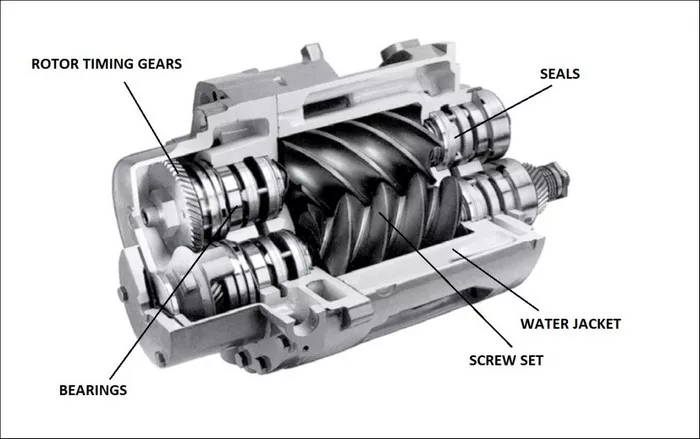The global oil-free screw compressor market is on track for sustained growth, buoyed by rising demand across industries that require contamination-free, energy-efficient air compression systems. According to recent projections, the market—valued at approximately US$3.2 billion in 2024—is expected to reach US$4.3 billion by 2031, registering a compound annual growth rate (CAGR) of 5.1%.
Growth is primarily driven by increasing adoption in sectors such as pharmaceuticals, food and beverage, electronics, and healthcare—industries where air purity is essential for product quality and regulatory compliance.
Regulations and Industrial Standards Drive Market Growth
Tightening global regulations related to air quality and contamination control are a key factor in the market’s upward trajectory. In industries such as pharmaceuticals, where even minimal contamination poses safety risks, oil-free screw compressors have become critical equipment. The pharmaceutical sector alone is forecasted to grow at a CAGR of 5.7%, fueled by strict manufacturing and packaging standards.
Among compressor types, stationary oil-free screw compressors dominate the market. Known for their reliability and capacity to deliver continuous, contaminant-free compressed air, these systems are the go-to solution for large-scale industrial operations. In contrast, portable oil-free screw compressors serve more specialized roles in industries requiring mobile and flexible air supply solutions, such as construction and automotive services.
North America Leads, India Emerges as Growth Hub
North America continues to hold the largest share of the global market, led by the United States. The region’s robust regulatory landscape and emphasis on sustainability and energy efficiency have accelerated the adoption of oil-free technologies. The presence of major manufacturers and advanced industrial ecosystems further reinforces market dominance.
In the Asia-Pacific region, India stands out as a high-growth market. Government initiatives like the “Make in India” campaign are fostering an industrial environment that increasingly favors clean and efficient technologies. Rapid growth in pharmaceuticals, food processing, and healthcare sectors has further bolstered demand. Meanwhile, China’s expanding electronics and automotive sectors are also contributing to regional growth.
Europe remains a significant market, supported by regulatory measures such as the European Union’s Ecodesign Directive, which mandates energy-efficient industrial equipment. Other regions—including Latin America, the Middle East, and Africa—are witnessing steady adoption as industrial modernization and quality standards gain momentum.
Segment Overview: Products and End-Use Applications
The market is segmented by product type—stationary and portable—and by end-use industry.
Stationary oil-free screw compressors account for the largest market share. Their widespread use in high-purity environments such as pharmaceutical manufacturing, electronics production, and food processing underscores their importance in sectors where compliance with air purity standards is non-negotiable.
Portable compressors, while representing a smaller market share, are critical for applications that require flexibility and mobility. Industries such as construction and automotive repair rely on these systems for on-site, contamination-free air supply.
From an industry perspective, pharmaceuticals remain the top end-user segment, both in terms of market share and growth rate. The food and beverage industry also commands a significant share, driven by hygiene requirements. Electronics manufacturers demand ultra-clean air to prevent contamination during production, while healthcare facilities use oil-free compressors for medical air systems. Automotive and other manufacturing sectors contribute to incremental growth based on contamination-control needs.
Key Market Drivers
A major driver of market expansion is the increasing need for high-purity compressed air in industries where contamination could compromise product integrity or safety. Manufacturers in pharmaceuticals, food processing, and electronics are under pressure to meet stringent international standards, spurring adoption of oil-free solutions.
Energy efficiency is another pivotal factor. Oil-free screw compressors typically offer lower energy consumption and reduced environmental impact compared to traditional oil-lubricated models. As industries work to reduce operational costs and carbon emissions, these systems are becoming increasingly attractive.
Technological advancements have also enhanced the market offering. Features like variable speed drives and intelligent control systems are improving performance and reducing maintenance demands. Government incentives supporting sustainable industrial practices further encourage businesses to invest in cleaner technologies.
Challenges and Constraints
Despite favorable trends, the market does face some constraints. One significant challenge is the limited capability of oil-free screw compressors in handling extremely high-pressure applications—a domain where oil-lubricated models still excel. This restricts the adoption of oil-free systems in specific industrial scenarios.
Additionally, the higher initial costs and more complex maintenance associated with oil-free compressors can be a barrier, particularly in emerging markets where technical expertise and service infrastructure are still developing. These challenges may slow broader market penetration in cost-sensitive regions or industries.
Related topics:

